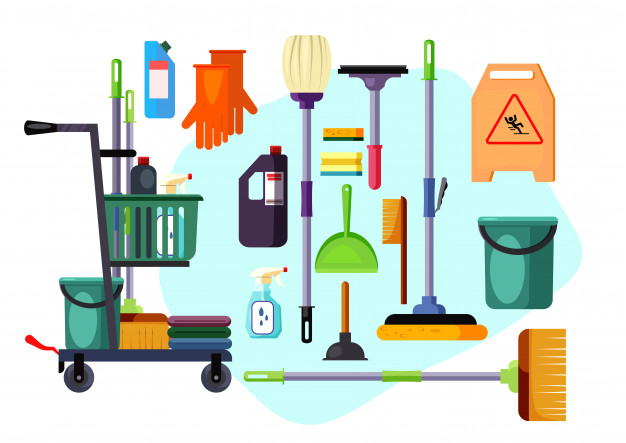Cleaning Techniques For Different Types Of Construction Materials
Building and maintaining structures requires a variety of cleaning techniques. Different construction materials require different types of cleaning to ensure they stay in good condition for as long as possible. Cleaning is often the most important step in the maintenance process, and it can play a huge role in how long structures last.
Cleaning Construction Materials
Here are some of the most effective cleaning techniques for different types of construction materials, including wood, metal, concrete and stone.
Wood
Wood is a popular construction material due to its durability and natural beauty. However, cleaning wood can be tricky as different types of wood require different cleaning techniques so Janitorial Contractor can help in cleaning wood materials.
For hardwoods such as oak or walnut, a simple mixture of mild soap and warm water can be used to clean the surface. Softwoods like pine or cedar, on the other hand, are more porous and require a gentler approach. A solution of vinegar and water can be used to remove dirt without damaging the wood.
It is important to note that excessive moisture can cause wood to warp or even rot over time. Thus, it is recommended to avoid using too much water when cleaning wood surfaces. Additionally, harsh chemical cleaners should also be avoided as they may strip off the protective finish of the wood.
When dealing with wooden furniture or accessories, it is best to use a soft cloth for wiping instead of abrasive scrubbers that may leave scratches on the surface. With proper care and maintenance, your wooden items will remain in good condition for years to come.
Steel
Steel is a commonly used material in the construction industry due to its strength, durability and versatility. When it comes to cleaning steel, there are different techniques that can be utilized depending on the type of finish or coating applied. For bare steel, mild detergent solutions or vinegar can be used to remove dirt and grime. However, for painted or powder-coated steel surfaces, harsh chemicals should be avoided as they may damage the finish.
One effective technique for cleaning painted or powder-coated steel is using a soft-bristled brush along with a mixture of warm water and mild detergent. The solution should then be rinsed off with clean water and dried thoroughly with a soft cloth to prevent water spots from forming. For tougher stains or debris buildup, a non-abrasive cleaner specifically formulated for painted metal surfaces can also be used.
Brick
Brick is a popular construction material due to its durability and aesthetic appeal. However, it can be prone to discoloration and staining over time. To clean brick, start by removing any loose dirt or debris with a stiff bristle brush. Next, mix together 1 part vinegar and 5 parts water in a bucket.
Using a soft-bristled brush, apply the solution to the brick and scrub gently until the stains are removed. Rinse thoroughly with clean water and allow the brick to dry completely before applying any sealant or paint.
It’s important to note that some types of brick may require professional cleaning techniques, such as sandblasting or chemical cleaning. These methods should only be performed by experienced professionals to avoid damage to the brick surface so contact us to get our expert’s services.
Concrete
Concrete is a popular construction material due to its strength and durability. However, it can also be susceptible to staining and discoloration if not properly maintained. When cleaning concrete, it’s important to first remove any loose debris or dirt using a broom or vacuum cleaner. Next, a mixture of warm water and mild soap can be applied to the surface using a soft-bristled brush or mop. For tougher stains such as oil or grease, a specialized concrete cleaner may be necessary.
It’s important to avoid using harsh chemicals or high-pressure washers when cleaning concrete as this can damage the surface. Instead, opt for gentle cleaning methods and take care not to scrub too vigorously in order to avoid leaving scratches or marks on the surface. Regular maintenance is key when it comes to keeping your concrete looking its best, so consider implementing a routine cleaning schedule in order to prevent the build-up of dirt and stains over time.
Glass
Glass is a popular material used in construction, especially in windows and doors. It is known for its transparency and ability to allow natural light into buildings. However, glass can be tricky to clean due to its fragility and susceptibility to scratches.
For regular cleaning of glass surfaces such as windows and mirrors, a simple solution of water and vinegar or dish soap can be used. Using a microfiber cloth or squeegee will help prevent streaking. If the glass surface has accumulated dirt or grime buildup, a mixture of rubbing alcohol and water can be effective in removing stubborn stains.
It’s important to note that different types of glass may require different cleaning techniques. For example, tempered glass should not be cleaned with abrasive materials as they can scratch the surface. On the other hand, the laminated glass may need special care when removing adhesives or sticker residue as some solvents may damage the interlayer film between layers of glass.
Ceramics
Ceramic materials are known for their durability and resistance to high temperatures, making them a popular choice for construction projects. However, cleaning ceramics can be tricky as they come in various forms such as tiles, pottery, and dishes. One way of cleaning ceramic tiles is by using a mixture of baking soda and vinegar. This solution not only removes dirt but also eliminates bacteria and mildew. For pottery pieces, it’s best to avoid using harsh chemicals as they can damage the glaze. Instead, use a soft-bristled brush or cloth with warm water to gently scrub away any stains.
When it comes to cleaning ceramic dishes, handwashing is recommended over using a dishwasher. Ceramic dishes are prone to chipping and cracking when exposed to sudden temperature changes or abrasive scrubbing tools like steel wool pads. To avoid these issues, soak the dishes in warm soapy water before washing them gently with a sponge or dishcloth. It’s also essential to rinse them thoroughly after washing and let them air dry completely before storing them.
Conclusion
In conclusion, cleaning construction materials requires a tailored approach to ensure the best results. For brick and concrete surfaces, high-pressure washing is effective in removing dirt and grime. However, for delicate surfaces such as marble or granite, gentler cleaning methods such as steam cleaning or using pH-neutral cleaners are recommended.
It is also important to consider the environmental impact of cleaning products used on construction materials. Eco-friendly solutions are becoming more readily available and can provide effective cleaning without harming the environment.
Regular maintenance and cleaning can extend the life of construction materials, saving time and money in the long run. By utilizing appropriate techniques, tools, and products for each surface type, you can ensure that your construction project remains clean and well-maintained for years to come.


Post Comment